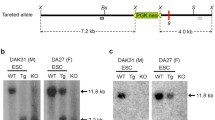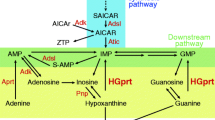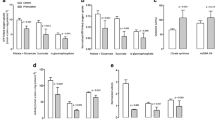Abstract
Lesch-Nyhan disease (LND) is a rare, X-linked recessive neurodevelopmental disorder caused by deficiency of hypoxanthine-guanine phosphoribosyltransferase (HGprt), an enzyme in the purine salvage pathway. HGprt has two functions; it recycles hypoxanthine and guanine. Which of these two functions is more relevant for pathogenesis is unclear because some evidence points to hypoxanthine recycling, but other evidence points to guanine recycling. In this study, we selectively assayed hypoxanthine (Hprt) and guanine (Gprt) recycling in skin fibroblasts from 17 persons with LND, 11 with an attenuated variant of the disease (LNV), and 19 age-, sex-, and race-matched healthy controls (HC). Activity levels of both enzymes differed across groups (p < 0.0001), but only Gprt distinguished patients with LND from those with LNV (p < 0.05). Gprt also showed slightly stronger correlations than Hprt with 13 of 14 measures of the clinical phenotype, including the severity of dystonia, cognitive impairment, and behavioral abnormalities. These findings suggest that loss of guanine recycling might be more closely linked to the LND/LNV phenotype than loss of hypoxanthine recycling.


Similar content being viewed by others
References
Achenbach TM, Rescorla LA (2001) Manual for ASEBA school-age forms & profiles. University of Vermont, Research Center for Children, Youth, & Families, Burlington, VT
Achenbach TM, Rescorla LA (2003) Manual for ASEBA adult forms & profiles. University of Vermont, Research Center for Children, Youth, & Families, Burlington, VT
Benton AL, Sivan AB, Hamsher KS et al (1994) Contributions to neuropsychological assessment: a clinical manual, 2nd edn. Oxford University Press, New York
Brandt J (1991) The hopkins verbal learning test: development of a new memory test with six equivalent forms. Clin Neuropsychol 5:125–142. doi:10.1080/13854049108403297
Burke RE, Fahn S, Marsden CD et al (1985) Validity and reliability of a rating scale for the primary torsion dystonias. Neurology 35:73–77
Curto R, Voit EO, Cascante M (1998) Analysis of abnormalities in purine metabolism leading to gout and to neurological dysfunctions in man. Biochem J 329(Pt 3):477–487
Deutsch SI, Long KDB, Rosse RB et al (2005) (2005) Hypothesized deficiency of guanine-based purines may contribute to abnormalities of neurodevelopment, neuromodulation, and neurotransmission in Lesch-Nyhan syndrome. Clin Neuropharmacol 28:28–37
Dunn LM, Dunn DM (1959) Peabody picture vocabulary test, fourth edn. manual. NCS Pearson, Inc, Minneapolis, MN
Fu R, Ceballos-Picot I, Torres RJ et al (2014) Genotype–phenotype correlations in neurogenetics: Lesch-Nyhan disease as a model disorder. Brain 137:1282–1303. doi:10.1093/brain/awt202
Fu R, Jinnah HA (2012) Genotype-phenotype correlations in Lesch-Nyhan disease moving beyond the gene. J Biol Chem 287:2997–3008. doi:10.1074/jbc.M111.317701
Fu R, Sutcliffe D, Zhao H et al (2015) Clinical severity in Lesch-Nyhan disease: the role of residual enzyme and compensatory pathways. Mol Genet Metab 114:55–61. doi:10.1016/j.ymgme.2014.11.001
Göttle M, Burhenne H, Sutcliffe D, Jinnah HA (2013) Purine metabolism during neuronal differentiation: the relevance of purine synthesis and recycling. J Neurochem 127:805–818. doi:10.1111/jnc.12366
Harkness RA, McCreanor GM, Watts RW (1988) Lesch-Nyhan syndrome and its pathogenesis: purine concentrations in plasma and urine with metabolite profiles in CSF. J Inherit Metab Dis 11:239–252
Jinnah HA, Ceballos-Picot I, Torres RJ et al (2010) Attenuated variants of Lesch-Nyhan disease. Brain J Neurol 133:671–689. doi:10.1093/brain/awq013
Jinnah HA, Harris JC, Nyhan WL, O’Neill JP (2004) The spectrum of mutations causing HPRT deficiency: an update. Nucleosides Nucleotides Nucleic Acids 23:1153–1160. doi:10.1081/NCN-200027400
Kaufman AS, Kaufman NL (1997) Kaufman brief intelligence test, second edn manual. NCS Pearson, Inc, Minneapolis, MN
Kelley WN, Greene ML, Rosenbloom FM et al (1969) Hypoxanthine–guanine phosphoribosyltransferase deficiency in gout. Ann Intern Med 70:155–206
Mateos FA, Puig JG (1994) Purine metabolism in Lesch-Nyhan syndrome versus Kelley-Seegmiller syndrome. J Inherit Metab Dis 17:138–142. doi:10.1007/BF00735419
Nihira K (1998) AAMR adaptive behavior scale residential and community: examiner’s manual. Pro-ed, Austin, TX
Page T, Bakay B, Nissinen E, Nyhan WL (1981) Hypoxanthine-guanine phosphoribosyltransferase variants: correlation of clinical phenotype with enzyme activity. J Inherit Metab Dis 4:203–206
Schretlen D (1997) Brief test of attention professional manual. Psychological Assessment Resources, Inc, Odessa, FL
Schretlen DJ, Inscore AB, Jinnah HA et al (2007) Serum uric acid and cognitive function in community-dwelling older adults. Neuropsychology 21:136–140. doi:10.1037/0894-4105.21.1.136
Schretlen DJ, Varvaris M, Ho TE et al (2013) Regional brain volume abnormalities in Lesch-Nyhan disease and its variants: a cross-sectional study. Lancet Neurol 12:1151–1158. doi:10.1016/S1474-4422(13)70238-2
Schretlen DJ, Ward J, Meyer SM et al (2005) Behavioral aspects of Lesch-Nyhan disease and its variants. Dev Med Child Neurol 47:673–677. doi:10.1017/S0012162205001374
Shirley TL, Lewers JC, Egami K et al (2007) A human neuronal tissue culture model for Lesch-Nyhan disease. J Neurochem 101:841–853. doi:10.1111/j.1471-4159.2007.04472.x
Shriner D, Baye TM, Padilla MA et al (2008) Commonality of functional annotation: a method for prioritization of candidate genes from genome-wide linkage studies†. Nucleic Acids Res 36:e26. doi:10.1093/nar/gkn007
Steiger JH (1980) Tests for comparing elements of a correlation matrix. Psychol Bull 87:245–251. doi:10.1037/0033-2909.87.2.245
Sweetman L, Nyhan WL (1970) Detailed comparison of the urinary excretion of purines in a patient with the Lesch-Nyhan syndrome and a control subject. Biochem Med 4:121–134. doi:10.1016/0006-2944(70)90089-X
Torres RJ, Puig JG (2007) Hypoxanthine-guanine phosophoribosyltransferase (HPRT) deficiency: Lesch-Nyhan syndrome. Orphanet J Rare Dis 2:48. doi:10.1186/1750-1172-2-48
Torres RJ, Puig JG, Jinnah HA (2012) Update on the phenotypic spectrum of Lesch-Nyhan disease and its attenuated variants. Curr Rheumatol Rep 14:189–194. doi:10.1007/s11926-011-0231-5
Vannorsdall TD, Jinnah HA, Gordon B et al (2008) Cerebral ischemia mediates the effect of serum uric Acid on cognitive function. Stroke 39:3418–3420. doi:10.1161/STROKEAHA.108.521591
Visser JE, Schretlen DJ, Harris JC, Jinnah HA (2005) Lesch-Nyhan disease. In: Goldstein S, Reynolds CR (eds) Handbook of neurodevelopmental and genetic disorders in adults. Guilford Press, New York, NY, pp 410–438
Conflict of Interest
David Schretlen received grant support from the National Institutes of Health (R01 HD053312) for the study described in this article. Under an agreement with Psychological Assessment Resources, Inc., Dr. Schretlen also is entitled to a share of royalty on sales of a test used in the study described in this article. The terms of this arrangement are being managed by the Johns Hopkins University in accordance with its conflict of interest policies.
Wynne Callon, Rebecca Ward, and Barry Gordon declare that they have no conflict of interest.
Rong Fu received grant support from the National Institutes of Health (R01 HD053312) for the study described in this article.
Tiffany Ho received grant support from the National Institutes of Health (R01 HD053312) for the study described in this article.
James Harris received grant support from the National Institutes of Health (R01 HD053312) for the study described in this article.
Barry Gordon
H. A. Jinnah received grant support from the National Institutes of Health (R01 HD053312) for the study described in this article.
Author information
Authors and Affiliations
Corresponding author
Additional information
Communicated by: Pascale de Lonlay
Rights and permissions
About this article
Cite this article
Schretlen, D.J., Callon, W., Ward, R.E. et al. Do clinical features of Lesch-Nyhan disease correlate more closely with hypoxanthine or guanine recycling?. J Inherit Metab Dis 39, 85–91 (2016). https://doi.org/10.1007/s10545-015-9869-x
Received:
Revised:
Accepted:
Published:
Issue Date:
DOI: https://doi.org/10.1007/s10545-015-9869-x




